
Major subsystems of a spacecraft bus work together to provide support to a satellite system’s operation. Space experts work hard to improve these subsystems in the spacecraft bus so that future space exploration missions are successful. The more technological knowledge we gain by analyzing how different subsystems of spacecraft bus work, the more we can perfect our space-exploring technology.
What is A Spacecraft Subsystem?
A spacecraft subsystem is one of the primary structures of a space bus. It supports hardware and payload instruments. Depending on each mission, the subsystem’s structure can vary. In other words, a space mission indicates what subsystems a bus should use. Space companies develop advanced spacecraft buses, depending on their application field. For example, some focus on communication, scientific research, exploration, navigation, and security, whereas others focus on mapping and surveillance. In this article, we will discuss major spacecraft bus components and their systems. These are the subsystems without which any spacecraft bus would not function. Any system is a predefined and single operating environment that an entire spacecraft system uses to coordinate its resource use and workflow.
What are The Most Important Spacecraft Subsystems?
A spacecraft bus could now work without an electrical power system first. Then another of the most important component is the attitude control subsystem. Communication and thermal control systems are also very important, so the following sections of this article will discuss them all. As its name suggests, the electrical power subsystem ensures payload and that the bus has enough power. The attitude control subsystem has observation purposes, whereas the communication subsystem consists of transmitters and receivers. The thermal control subsystem ensures that a space vehicle functions at normal temperatures. These four top systems are the most important because, without them, a spacecraft bus would not function properly. They keep all other systems working, too, so let’s see what each does.
Also read: Get Rich Quick? 30 Best Money Making Apps To Turn Your Spare Time Into CashElectrical Power Subsystem
The electrical power of space buses uses solar panels. Without these solar panels, solar radiation would not become an electrical current to power an entire spacecraft. It’s important to have large solar panels that hinge and fold during launch and as soon as the spacecraft gets deployed into orbit. There are also power systems that use batteries. These batteries store energy for the spacecraft to use when located in our planet’s shadow. Usually, an electrical power grid is connected to other systems of a space bus through wires and electrical components. It delivers power to all attached sensors, starting at the power feed equipment, and ending at the final output voltage filters and voltage.
Attitude Control Subsystem
The attitude control subsystem is in charge of orienting and controlling a space bus. It does so with respect to a reference, inertial frame, or other space entity, which can be a certain field, a celestial sphere, or any nearby object. This component uses sensors and measures a vehicle’s spatial orientation and altitude. Stabilizing and controlling spacecraft attitude is essential for precise data collection or interpretation. Attitude control would be impossible without attitude measurement and determination, which the attitude control component takes care of statically, using measurements that have been taken before. The attitude control subsystem can also employ the Kalman filter to take statistical measurements.
Communication Subsystem
With the help of transmitters and receivers, the communication segment relays data back to Earth. Radio signals transmit the software commands. This component also ensures that two satellites communicate clearly with each other. Its signals are electromagnetic pulses that transmitters manipulate for receivers to decrypt. The communication subsystem segment uses transceivers or antennae that communicate with monitoring stations to receive instructions or send collected data. All information transmitted by this subsystem could also be spacecraft housekeeping or payload mission data. Operations center users need such data to control spacecraft buses or operate payloads. Without this major component, we would not be able to control spacecraft buses remotely.
Thermal Control
Keeping temperatures at set parameters during a lifetime, the thermal control segment ensures spacecraft bus equipment doesn’t encounter a too high temperature that could severely affect how a space bus works. Thermal devices feature cryocoolers, electrical resistance heaters, fluid loops, and thermoelectric coolers. A spacecraft bus changes temperature according to power demand, given orbits, operations, and other factors. A thermal control system reduces temperature gradients across an entire spacecraft bus and even for some specific components, such as lenses. Without it, a mission would not be successful, and a spacecraft bus would not perform at optimal levels. Temperatures would be either too low or too high, and different extreme temperatures could damage space bus performance.
The first and most important subsystem of a spacecraft bus is its electrical power subsystem. Then, the attitude control subsystem works to keep a vehicle and bus operating in control. The communication segment sends data to the ground or another vehicle, whereas the thermal control system ensures that an entire structure doesn’t become damaged by extreme temperatures.
Top 10 News
-
01
[10 BEST] AI Influencer Generator Apps Trending Right Now
Monday March 17, 2025
-
02
The 10 Best Companies Providing Electric Fencing For Busines...
Tuesday March 11, 2025
-
03
Top 10 Social Security Fairness Act Benefits In 2025
Wednesday March 5, 2025
-
04
Top 10 AI Infrastructure Companies In The World
Tuesday February 11, 2025
-
05
What Are Top 10 Blood Thinners To Minimize Heart Disease?
Wednesday January 22, 2025
-
06
10 Top-Rated AI Hugging Video Generator (Turn Images Into Ki...
Monday December 23, 2024
-
07
10 Top-Rated Face Swap AI Tools (Swap Photo & Video Ins...
Friday December 20, 2024
-
08
10 Exciting iPhone 16 Features You Can Try Right Now
Tuesday November 19, 2024
-
09
10 Best Anatomy Apps For Physiologist Beginners
Tuesday November 12, 2024
-
10
Top 10 Websites And Apps Like Thumbtack
Tuesday November 5, 2024







